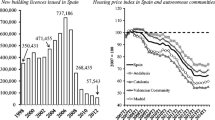Abstract
The dynamics of residential sorting have been previously explored using segregation models. In contrast with these models which emphasize resultant spatial distributions, this paper suggests an approach of assessing temporal income sorting trends through the analysis of residential mobility patterns. The approach is focused on ‘gains’ in neighborhood socioeconomic status experienced by movers as a result of residential relocation. The analysis of income sorting trends is based upon the analysis of inter-group differentials in these gains over time. Trends in income sorting are assumed to follow temporal variations in exogenous factors such as housing market circumstances. As different age groups are assumed to respond differently to these variations, income sorting is expected to evolve to some extent on the basis of age. An empirical example demonstrates the application of this approach to intra-metropolitan residential mobility data collected for the Tel-Aviv metropolitan area through the years 1997–2008.





Similar content being viewed by others
Notes
Based on disposable income, after taxes and transfers, OECD data.
As moves are carried out by households, records cannot be assumed to be independent of each other. Thus the analysis is restricted to methods that do not involve violation of such required assumption.
Income deciles were calculated based on national income distributions for each year respectively. Data was provided to CBS by the National Insurance Institute. As missing income decile may indicate unemployment, labor force nonparticipation, missing data, or undeclared income, we chose not to include these records. Mover income records from 1999 onwards include earnings from both employment and self-employment, while 1997–8 records include earnings from salaried employment only.
Age is top-coded at 65 and hence we defined age-groups to be used as a categorical variable.
New areas that were built between 1995 and 2008 and were missing 1995 attribute values were assigned estimated values based on 2008 values and variable predicted growth rates. Predictions were carried out using decision tree models, where the dependent variable was the neighborhood growth rate of the examined variable from 1995 to 2008, and independent variables were: average growth rate of the variable in the city quarter in which the tract is situated, demographic and geographic variables.
References
Banks, J., Blundell, R., Oldfield, Z., Smith, J.P.: Housing price volatility and downsizing in later life. In: Wise, D.A. (ed.) Research Findings in the Economics of Aging, pp. 337–379. University of Chicago Press (2010)
Clark, W.A., Deurloo, M.C.: Aging in place and housing over-consumption. J. Hous. Built Environ. 21(3), 257–270 (2006)
Clark, W.A., Deurloo, M.C., Dieleman, F.M.: Tenure changes in the context of micro-level family and macro-level economic shifts. Urban Stud. 31(1), 137–154 (1994)
Clark, W.A., Deurloo, M.C., Dieleman, F.M.: Housing careers in the United States, 1968–93: modelling the sequencing of housing states. Urban Stud. 40(1), 143–160 (2003)
Clark, W., Deurloo, M., Dieleman, F.: Residential mobility and neighborhood outcomes. Hous. Stud. 21(3), 323–342 (2006)
Clark, W., Dieleman, F.: Households and Housing: Choice and Outcomes in the Housing Market. Rutgers. State University of New Jersey, Center for Urban Policy Research, New Brunswick, NJ (1996)
Clark, W.A., Morrison, P.S.: Socio-spatial mobility and residential sorting: evidence from a large-scale survey. Urban Stud. 49(15), 3253–3270 (2012)
Clark, W.A., Van Ham, M., Coulter, R.: Spatial mobility and social outcomes. J. Hous. Built Environ. 29(4), 699–727 (2013)
Hanushek, E.A., Quigley, J.M.: An explicit model of intra-metropolitan mobility. Land Econ. 54(4), 411–429 (1978)
Henderson, J.V., Ioannides, Y.M.: Dynamic aspects of consumer decisions in housing markets. J. Urban Econ. 26(2), 212–230 (1989)
Kendig, H.L.: Housing careers, life cycle and residential mobility: implications for the housing market. Urban Stud. 21(3), 271–283 (1984)
Kendig, H.L.: A life course perspective on housing attainment. In: Myers, D. (ed.) Housing Demography: Linking Demographic Structure and Housing Markets, pp. 133–156. University of Wisconsin Press, Madison, WI (1990)
Kipnis, B.A.: Graph analysis of metropolitan residential mobility: methodology and theoretical implications. Urban Stud. 22(2), 179–187 (1985)
Krakover, S.: Spatio-temporal trends of housing and population growth during a building cycle: evidence from metropolitan Tel-Aviv, 1968 to 1990. Urban Geogr. 20(3), 226–245 (1999)
Li, W., Yao, R.: The life-cycle effects of house price changes. J. Money Credit Bank. 39(6), 1375–1409 (2007)
Michelson, W.: Environmental Choice, Human Behavior, and Residential Satisfaction. Oxford University Press, New York (1977)
Morrow-Jones, H.A., Wenning, M.V.: The housing ladder, the housing life-cycle and the housing life-course: upward and downward movement among repeat home-buyers in a US metropolitan housing market. Urban Stud. 42(10), 1739–1754 (2005)
Myers, D.: Cohort longitudinal estimation of housing careers. Hous. Stud. 14(4), 473–490 (1999)
Nagar, W., Segal, G.: What explains the development of home prices and rents in Israel, 2009–10? Bank Israel Econ. Survey 85, 7–59 (2011)
Quigley, J.M., Weinberg, D.H.: Intra-urban residential mobility: a review and synthesis. Int. Reg. Sci. Rev. 2(1), 41–66 (1977)
Reardon, S.F., Bischoff, K.: Income inequality and income segregation. Am. J. Sociol. 116(4), 1092–1153 (2011)
Rossi, P.H.: Why Families Move: A Study in the Social Psychology of Urban Residential Mobility. Free Press, Glencoe, IL (1955)
Sayag, D.: Measuring Local House Price Movements in Israel and Estimating Price Elasticity. Israel Econ. Rev. 10(1), 39–94 (2012)
Speare, A., Goldstein, S., Frey, W.H.: Residential Mobility, Migration, and Metropolitan Change. Ballinger Publishing Company, Cambridge (1975)
Turner, T.M.: Does investment risk affect the housing decisions of families? Econ. Inquiry 41(4), 675–691 (2003)
Watson, T.: Inequality and the measurement of residential segregation by income in American neighborhoods. Rev. Income Wealth 55(3), 820–844 (2009)
Weinberg, D.H.: The determinants of intra-urban household mobility. Reg. Sci. Urban Econ. 9(2), 219–246 (1979)
Acknowledgments
This research was supported by the Azrieli Foundation, the Israel Foundations Trustees Program for the Advancement of Research in the Social Sciences, and the Shlomo Glass and Penny Balaban Fund. The authors thank two anonymous reviewers for their constructive comments.
Author information
Authors and Affiliations
Corresponding author
Rights and permissions
About this article
Cite this article
Modai-Snir, T., Plaut, P.O. Intra-metropolitan residential mobility and income sorting trends. Lett Spat Resour Sci 8, 291–305 (2015). https://doi.org/10.1007/s12076-014-0133-z
Received:
Accepted:
Published:
Issue Date:
DOI: https://doi.org/10.1007/s12076-014-0133-z




